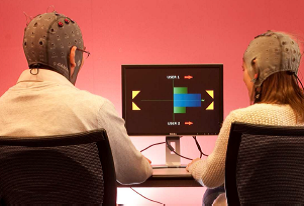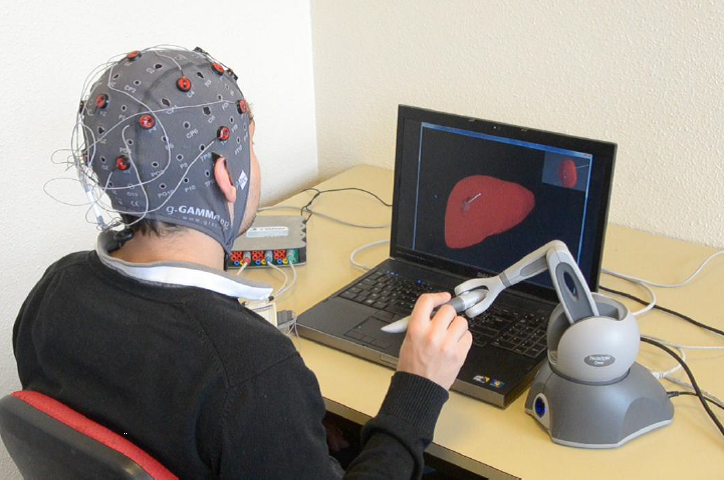Section: New Results
Brain-Computer Interfaces and Virtual Environments
Multi-user BCI video game
Participant : Anatole Lécuyer [contact] .
How can we connect two brains to a video game by means of a BCI, and what will happen when we do so? How will the two users behave, and how will they perceive this novel common experience? We have created a multi-user videogame called “BrainArena” in which two users can play a simple football game by means of two BCIs [15] , as illustrated Figure 8 . They can score goals on the left or right side of the screen by simply imagining left or right hand movements. To add another interesting element , the gamers can play in a collaborative manner (their two mental activities are combined to score in the same goal), or in a competitive manner (the gamers must push the ball in opposite directions). Two experiments were conducted to evaluate the performance and subjective experience of users in the different conditions. Taken together our results suggest that multi-user BCI applications can be operational, effective, and more engaging for participants.
This work was a collaboration with the Potioc team (Inria Bordeaux).
|
Contextual SSVEP-based BCI control
Participants : Jozef Legény, Anatole Lécuyer [contact] .
One main disadvantage of Brain-Computer Interfaces is that they are not completely reliable. In order to increase BCI performances, some adjustments can be made on low levels, such as signal processing and on high levels by modifying the controller paradigm. We have explored a novel, context-dependent, approach for SSVEP-based BCI controller [23] . This controller uses two kinds of behaviour alternation, commands can be added and removed if their use is irrelevant to the context or the actions resulting from their activation can be weighted depending on the likeliness of the actual intention of the user. This controller has been integrated within a BCI computer game and its influence in performance and mental workload has been addressed through a pilot experiment. Preliminary results have shown a workload reduction and performance improvement with the context-dependent controller while keeping the engagement levels untouched.
This work was a collaboration with the Universidad de Jaen (Spain) .
Can we use a BCI and manipulate a mouse at the same time?
Participants : Jonathan Mercier-Ganady, Anatole Lécuyer [contact] , Maud Marchal.
In most setups using a BCI, the user is explicitly asked to remain as motionless as possible, since muscular activity is commonly admitted to add noise and artifacts in brain electrical signals. Thus, as for today, people have been rarely let using other classical input devices such as mice or joysticks simultaneously to a BCI-based interaction. We have conducted an experimental study on the influence of manipulating an input device such as a standard computer mouse on the performance of a BCI system [38] . The study uses a simple virtual environment inspired by the well-known Pac-Man videogame and based on BCI and mouse controls. As expected the BCI performance was found to slightly decrease in presence of motor activity. However, we found that the BCI could still be successfully used in all conditions, even in presence of a highly-demanding mouse manipulation. These promising results pave the way to future experimental studies with more complex mental and motor activities, but also to novel 3D interaction paradigms that could mix BCI and other input devices for virtual reality and videogame applications.
Adaptive VR simulators combining visual, haptic, and BCIs
Participants : Anatole Lécuyer [contact] , Maud Marchal.
What if the next generation of virtual reality simulators would take into account a novel user’s input: his/her mental state, as measured with electrodes and Brain-Computer Interfaces ? This would lead to adaptive simulators that could match the “hidden” expectations of the user optimally? We have initiated and illustrated this promising path with a virtual reality setup in which the force-feedback of a guidance system is adapted in real-time to the “mental workload” of the user [24] . A first application of this approach is a medical simulator in which virtual assistances are automatically adapted to surgeon and trainee's mental activity as illustrated Figure 9 . Such results pave the way to future virtual reality systems which would automatically reconfigure and adapt to cerebral inputs and cognitive processes.
|



